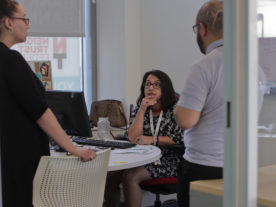
Mega Colon, or Hirschprung’s Disease, occurs when the muscles receive no signals to contract and move waste through the system, causing chronic constipation that leads to over-development of the colon. (Courtesy Mütter Museum)
MORE ABOUT AMERICA
Wild West Ghost Town Emerges from Watery Grave
What Happens When Americans Tweet What They Eat
The city of Philadelphia, in the East Coast state of Pennsylvania, has a storied history.
From 1790 to 1800, the city served as the temporary capital of the United States and was home to the two Continental Congresses, where delegates adopted the Declaration of Independence, the nation’s founding document. Tourists still flock to see the Liberty Bell, an iconic symbol of American independence.
Also tucked away in this historic city is the most visited medical museum in the world.
Officially known as the Mütter Museum of the College of Physicians of Philadelphia, the site is sometimes referred to as the Museum of Medical Monstrosities.
The repository isn’t afraid to have a little fun with itself.
Its website invites visitors to “become disturbingly informed.” Exhibits have slightly sensationalistic names such as “Secret Tumor of Grover Cleveland” and “This Dust Was Once a Man: The Final Days of Abraham Lincoln.”
However, despite a sometimes irreverent tone, the Mütter Museum has a serious purpose.
“This museum has always been an educational museum,” said curator Anna Dhody, “a place where physicians in training would come and see amazing specimens of the human condition.”
About 141,000 people visit the Mütter Museum each year; adults pay a general admission of $15. These days, the majority of folks who stop by are not connected to the medical profession. Museum officials say the visitorship is as diverse as the collection itself. The curious include everyone from school groups to celebrities, including singer Katy Perry, who dropped by recently.
Some of the more popular exhibits include a giant colon and the so-called Soap Lady, a body exhumed in 1875. The gift shop sells a colon plush toy and Soap Lady soap. Other curiosities include the skeleton of a giant man, Albert Einstein’s brain, a “death cast” of conjoined twins, and a sizable skull collection.

The skeleton of Harry Eastlack, a sufferer of Fibrodysplasia Ossificans Progressiva (FOP) which caused the formation of extra-skeleton bones. (Evi Numen/Mütter Museum)
“Mütter is really a museum of humanity and what it means to be human and how to alleviate suffering,” said J. Nathan Bazzel, the museum’s communications director. “Everything is here for a purpose; it is not here just because it’s weird. It’s also here so we can learn how to alleviate hurt.”
Consider the case Harry Eastlack, whose struggle with Fibrodysplasia Ossificans Progressiva (FOP) caused the formation of extra-skeletal bone. While he was alive, Eastlack worked with his doctor to ensure that his skeleton would be donated to science after his death.
“You are surrounded by so much grief and pain and suffering, which is really what most of these people went through,” said Bazzel. “But because of their gift of themselves, in many cases, we’ve learned how to resolve these issues so that others don’t suffer.”
Working at the museum has encouraged Dhody and Bazzel to literally give of themselves, too.
Dhody donated her kidney stone while both of Bazzel’s hips – which degenerated due to early-era AIDS medication he took years ago – are part of the museum’s ever-growing collection.
The museum’s seriousness of purpose is evidenced by its newly established research arm. Data from its extensive Hyrtl Skull collection is now online to help further medical and scientific research.
“We’ve had researchers using it to research how to construct a better football helmet to minimize concussions,” Dhody said. “We’re utilizing this 19th century collection for a 21st century issue.”
The most-visited page of the museum’s website is its write-up on vaccines. And cholera was recently extracted from the specimens of six people who died of the disease in 1849. Those samples are being used today to trace the lineage of that particular strain of cholera in hopes of finding a way to combat the disease.
Despite Mütter’s serious medical and scientific endeavors, museum officials recognize most visitors want to get an eyeful of the gross and the bizarre. Still, they hope the curious come away with more.
“People are interested in what it means to be human,” Bazzel said. “[The museum] challenges folks to think about humanity in a very different way.”

























It’s nice to finally find decent postings such as this. I really enjoyed this.